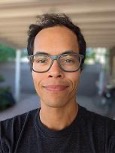How could an equation developed by a German mathematician in 1909 help Micronesian conservation networks plan for the future in the face of climate change?
In this week’s episode, we interview Dr. Steven Johnson, a graduate of Oregon State University’s Geography graduate program. Steven completed his doctorate earlier in 2021, under the guidance of Dr. James Watson, a professor in the College of Earth, Ocean, and Atmospheric Sciences. He’s now a postdoctoral fellow at Arizona State University. During his time at Oregon State, the focus of his work was oceans. “I study the ocean – in particular, people’s relationship with the ocean. The condition of the ocean has implications for people all over the world and millions depend on it for their livelihood,” he explains.
“There used to be this idea that the ocean was ‘too big to fail’, but Oregon State University Distinguished Professor and White House Deputy Director for Climate and the Environment Jane Lubchenco made the point that ‘the ocean is too big to fail, but too big to ignore,’” Steven recounts. “Not a single part of the ocean has not been impacted by people.” Plastic waste, rising temperatures, increasing acidification, and other byproducts of human activity have been changing the ocean as we know it, and it will continue to worsen if the problem can’t be solved. One challenge that arises as a result of these changes is the future of aquatic resource management and conservation programs, which are designed to work in current ocean and climate conditions.
So how does Steven’s research tackle these problems? In the first chapter of his thesis, he developed a novel model for predicting the way the ocean will change due to climate change. This approach is titled the Ocean Novelty Index, or the ONo Index. The Ocean Novelty Index quantifies the relative impact of climate change across all parts of the ocean, using a statistical metric applied to six different ocean surface variables (chlorophyll, O2, pH, sea surface temperature, silica, and zooplankton.) The metric is derived from the Hellinger distance, developed by a German mathematician in 1909, which is a nonparametric analysis that measures the similarity and dissimilarity between two distributions and their overlap. The baseline, or ‘normal’, conditions are derived from the period between 1970-2014, a 50 year period which recognizes 1970 as the birth of the modern Western climate movement. The model can then be used to assess and predict what climate change will do to one part of the ocean, and compare it to how that part of the ocean looked previously. The model better encapsulates the dynamic and unpredictable changes of the ocean resulting from climate change, as opposed to just rising temperatures.
In addition to the development of this climate change index, Steven’s research also focused on conservation networks and initiatives across Micronesia, the Caribbean, and Southeast Asia. These networks and cooperatives are collaborative efforts between regional governments to meet certain conservation goals, taking into account the differing social, cultural, and economic needs of the different countries involved. Part of Steven’s work has focused on applying the ONo index on a local scale, to help determine what changes may occur in the regions as well as where. What will the regions of these networks look like at different points as the climate changes, and how can we create strong policies and political relationships in these cooperatives and their respective countries to ameliorate potential issues in the future? Steven discusses these topics and more with us on this week’s ID podcast.
If you are interested in learning more about the ONo index and Steven’s work, you can read his paper here.
This post was written by Grace Deitzler







